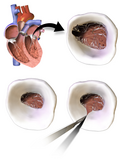Commissurotomy
Commissurotomy
Commissurotomy is a surgical procedure that involves cutting or disrupting the commissures, which are the connections between the two hemispheres of the brain. This procedure is primarily used to treat severe cases of epilepsy that do not respond to medication. By severing the corpus callosum, the largest commissure in the brain, the spread of epileptic seizures from one hemisphere to the other can be reduced or eliminated.
History[edit]
The concept of commissurotomy dates back to the mid-20th century when neurosurgeons began exploring surgical options for treating epilepsy. The procedure gained prominence in the 1960s through the work of Roger Sperry and Michael Gazzaniga, who conducted pioneering research on split-brain patients. Their studies provided significant insights into the lateralization of brain function and the role of the corpus callosum in interhemispheric communication.
Indications[edit]
Commissurotomy is typically indicated for patients with intractable epilepsy, particularly those who experience generalized seizures that originate in one hemisphere and spread to the other. Candidates for the procedure often have not responded to antiepileptic drugs and may have a high frequency of debilitating seizures.
Procedure[edit]
The surgical procedure involves a craniotomy, where a section of the skull is removed to access the brain. The neurosurgeon then identifies and severs the corpus callosum, which is the primary pathway for communication between the left and right hemispheres. The extent of the sectioning can vary, with some procedures involving a complete callosotomy and others a partial callosotomy, depending on the patient's condition and the surgeon's assessment.
Outcomes and Effects[edit]
Commissurotomy can significantly reduce the frequency and severity of seizures in patients with severe epilepsy. However, it also results in a "split-brain" condition, where the two hemispheres of the brain cannot communicate effectively. This can lead to unique neurological phenomena, such as the inability to verbally identify objects processed by the non-dominant hemisphere.
Risks and Complications[edit]
As with any major brain surgery, commissurotomy carries risks, including infection, bleeding, and adverse reactions to anesthesia. Postoperative complications may include cognitive and sensory deficits, although these are often outweighed by the benefits of seizure reduction.
Research and Developments[edit]
Ongoing research in the field of neurology and neurosurgery continues to explore the long-term effects of commissurotomy and its impact on brain function. Advances in imaging and surgical techniques aim to improve the safety and efficacy of the procedure.
Also see[edit]
| Seizures and epilepsy | ||||||||||
|---|---|---|---|---|---|---|---|---|---|---|
|
-
Commissurotomy
Ad. Transform your life with W8MD's Budget GLP-1 injections from $75


W8MD offers a medical weight loss program to lose weight in Philadelphia. Our physician-supervised medical weight loss provides:
- Weight loss injections in NYC (generic and brand names):
- Zepbound / Mounjaro, Wegovy / Ozempic, Saxenda
- Most insurances accepted or discounted self-pay rates. We will obtain insurance prior authorizations if needed.
- Generic GLP1 weight loss injections from $75 for the starting dose.
- Also offer prescription weight loss medications including Phentermine, Qsymia, Diethylpropion, Contrave etc.
NYC weight loss doctor appointmentsNYC weight loss doctor appointments
Start your NYC weight loss journey today at our NYC medical weight loss and Philadelphia medical weight loss clinics.
- Call 718-946-5500 to lose weight in NYC or for medical weight loss in Philadelphia 215-676-2334.
- Tags:NYC medical weight loss, Philadelphia lose weight Zepbound NYC, Budget GLP1 weight loss injections, Wegovy Philadelphia, Wegovy NYC, Philadelphia medical weight loss, Brookly weight loss and Wegovy NYC
|
WikiMD's Wellness Encyclopedia |
| Let Food Be Thy Medicine Medicine Thy Food - Hippocrates |
Medical Disclaimer: WikiMD is not a substitute for professional medical advice. The information on WikiMD is provided as an information resource only, may be incorrect, outdated or misleading, and is not to be used or relied on for any diagnostic or treatment purposes. Please consult your health care provider before making any healthcare decisions or for guidance about a specific medical condition. WikiMD expressly disclaims responsibility, and shall have no liability, for any damages, loss, injury, or liability whatsoever suffered as a result of your reliance on the information contained in this site. By visiting this site you agree to the foregoing terms and conditions, which may from time to time be changed or supplemented by WikiMD. If you do not agree to the foregoing terms and conditions, you should not enter or use this site. See full disclaimer.
Credits:Most images are courtesy of Wikimedia commons, and templates, categories Wikipedia, licensed under CC BY SA or similar.
Translate this page: - East Asian
中文,
日本,
한국어,
South Asian
हिन्दी,
தமிழ்,
తెలుగు,
Urdu,
ಕನ್ನಡ,
Southeast Asian
Indonesian,
Vietnamese,
Thai,
မြန်မာဘာသာ,
বাংলা
European
español,
Deutsch,
français,
Greek,
português do Brasil,
polski,
română,
русский,
Nederlands,
norsk,
svenska,
suomi,
Italian
Middle Eastern & African
عربى,
Turkish,
Persian,
Hebrew,
Afrikaans,
isiZulu,
Kiswahili,
Other
Bulgarian,
Hungarian,
Czech,
Swedish,
മലയാളം,
मराठी,
ਪੰਜਾਬੀ,
ગુજરાતી,
Portuguese,
Ukrainian
